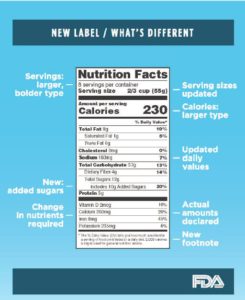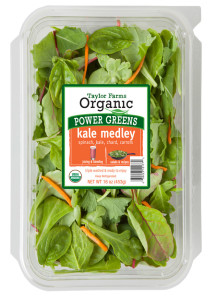New food label! Congratulations Let’s Move! & FDA
I kept hearing rumors this week that Michelle Obama would announce the revised Nutrition Facts panel at today’s summit meeting of the Partnership for a Healthier America, the public-private partnership organization that supports Let’s Move!
And here is the graphic from the White House press release:
Congratulations on the long-awaited changes:
- Calories big and bold
- Added sugars

- Serving sizes updated
- “Dual column” labels for “per serving” and “per package”
- Daily Value footnote: “The % Daily Value (DV) tells you how much a nutrient in a serving of food contributes to a daily diet. 2,000 calories a day is used for general nutrition advice.”
- Nutrients: Vitamin D, Calcium, Iron, and Potassium. Voluntary: Vitamins A and C.
Expect to see this on food packages in two years (small food producers get an additional year to comply).
Here are the relevant FDA documents:
- Federal Register notice on the food labels (943 pages)
- Federal Register notice on serving sizes (170 pages)
- Slide show
- Commissioner’s statement (“Voice Blog”)
- Changes to the Nutrition Facts Label
- At a Glance Fact Sheet
- Web Q&A
Here are the early comments (I will be adding more as they arrive):
- Helena Evich Bottemiller in Politico Morning Agriculture (I’m quoted).
- CSPI’s congratulatory statement
- Julia Belluz in Vox (I’m quoted)
- Sabrina Tavernise in the New York Times (I’m quoted)
- Roberto Ferdman in the Washington Post (I’m quoted)
- The Sugar Association’s response: “We are concerned that the ruling sets a dangerous precedent that is not grounded in science, and could actually deter us from our shared goal of a healthier America.”
The new food label is an extraordinary accomplishment, especially in the light of a political climate in which the food industry and its friends in Congress fight public health nutrition measures tooth and nail.
For background, see some of my posts on food labels since 2008:
- Food-Navigator’s review of what’s happening with the label proposals, 2014
- The FDA’s last call for comments on the label proposals, 2014
- The politics of the FDA’s proposed labels, 2014
- CSPI’s petition for Added Sugars, 2013
- The FDA’s first call for comments, 2008
Addition, May 26: Politico reports that 6 food trade groups commissioned a study to demonstrate that the cost of implementing the new food labels would be much higher than estimated by the FDA. Although the paper does not disclose its funding (or if it does, I missed it), Politico says the funders included the Corn Refiners Association, the Grocery Manufacturers Association, the Sugar Association, the American Bakers Association, and the International Dairy Foods Association. As with most industry-funded studies, they got what they paid for.





